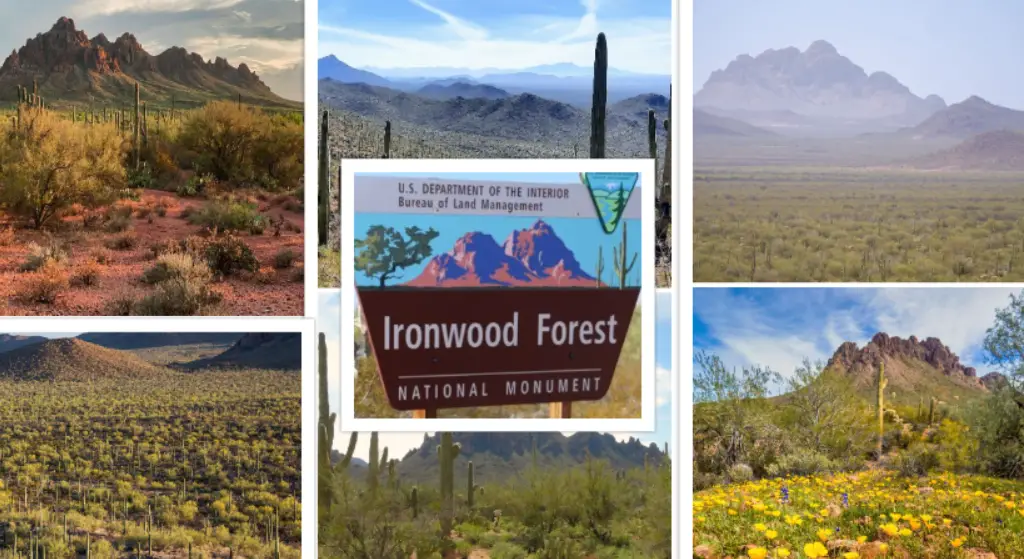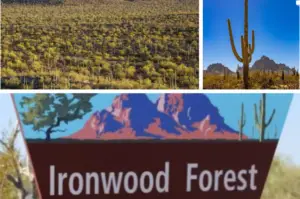Ironwood Forest National Monument : Interesting Facts, History & Travel Guide

- By
- Aparna Patel
- |
- 1 Apr, 2023
- |

Welcome to our guide on Ironwood Forest National Monument! Located in southern Arizona, this unique and beautiful destination covers over 129,000 acres of land and offers visitors a chance to explore the natural beauty and cultural heritage of the American Southwest. In this guide, we will explore the history, interesting facts, and travel tips for visiting Ironwood Forest National Monument. Whether you’re a hiker, rock climber, or just looking to experience the beauty of the desert, Ironwood Forest National Monument has something for everyone. Let’s dive in!
Table of Contents
Interesting facts about Ironwood Forest National Monument
Some interesting facts about Ironwood Forest National Monument:
- Ironwood Forest National Monument is located in southern Arizona, just northwest of Tucson.
- The monument covers over 129,000 acres and is home to a diverse array of plants and animals, including the iconic ironwood tree.
- The ironwood tree is one of the longest-living tree species in the world, with some individuals living up to 800 years.
- The monument is also home to several other unique plant species, including the saguaro cactus, ocotillo, and mesquite.
- Ironwood Forest National Monument was designated a national monument in 2000 by President Bill Clinton.
- The monument is home to several important cultural sites, including ancient petroglyphs and ruins left by the Hohokam and Tohono O’odham peoples.
- The Silver Bell Mountains, located within the monument, are a popular destination for hikers and rock climbers.
- The monument is also home to several endangered and threatened species, including the Sonoran Desert tortoise and the lesser long-nosed bat.
- Visitors to the monument can explore a variety of trails, ranging from easy walks to challenging hikes.
- The monument is located near several other popular destinations in southern Arizona, including Saguaro National Park and the city of Tucson.
Information & History of Ironwood Forest National Monument
The iconic ironwood tree, which gives the monument its name, is one of the longest-living tree species in the world, with some individuals living up to 800 years. The tree is a keystone species in the Sonoran Desert ecosystem and provides important habitat and resources for a wide variety of animals.
The monument is also home to several other unique plant species, including the saguaro cactus, ocotillo, and mesquite. These plants have adapted to survive in the harsh desert environment and play important roles in the ecosystem.
Ironwood Forest National Monument was designated a national monument in 2000 by President Bill Clinton. The designation was intended to protect the unique natural and cultural resources of the area, including important cultural sites left by the Hohokam and Tohono O’odham peoples.
The monument is home to several ancient petroglyphs and ruins, which provide a glimpse into the lives of the people who lived in the area thousands of years ago. These sites are considered sacred by many Native American communities and are an important part of the cultural heritage of the region.
The Silver Bell Mountains, located within the monument, are a popular destination for hikers and rock climbers. Visitors can explore a variety of trails, ranging from easy walks to challenging hikes, and enjoy stunning views of the surrounding desert landscape.
Ironwood Forest National Monument is also home to several endangered and threatened species, including the Sonoran Desert tortoise and the lesser long-nosed bat. The monument plays an important role in protecting the habitat of these species and promoting their conservation.
Today, Ironwood Forest National Monument remains an important and unique part of the American Southwest, offering visitors a chance to explore the natural beauty and cultural heritage of the region.
Read More:
- Hovenweep National Monument : Interesting Facts, History & Travel Guide
- Hohokam Pima National Monument : Interesting Facts, History & Travel Guide
- Harriet Tubman Underground Railroad National Monument : Interesting Facts, History & Travel Guide
- Hanford Reach National Monument : Interesting Facts, History & Travel Guide
- Hagerman Fossil Beds National Monument : Interesting Facts, History & Travel Guide
- Grand Staircase–Escalante National Monument : Interesting Facts, History & Travel Guide
- Grand Portage National Monument : Interesting Facts, History & Travel Guide
Travel Guide for Ironwood Forest National Monument
- Getting there: The monument is located about 25 miles northwest of Tucson. You can reach it via the Silver Bell Road exit off of I-10. From there, follow signs to the monument.
- Visitor center: There is no visitor center at Ironwood Forest National Monument. However, there is a BLM office in Tucson where you can pick up maps and other information about the monument.
- Hiking: The monument offers a variety of hiking trails for visitors of all skill levels. The Silver Bell Mountains are a popular destination for hikers and rock climbers. Be sure to bring plenty of water and wear appropriate footwear, as the desert can be rugged and challenging.
- Camping: There are no established campsites at Ironwood Forest National Monument. However, visitors are allowed to camp in designated areas for up to 14 days. Be sure to follow Leave No Trace principles and pack out all trash and waste.
- Wildlife viewing: The monument is home to a variety of wildlife, including desert bighorn sheep, coyotes, and rattlesnakes. Visitors should take care to observe wildlife from a safe distance and never feed or approach them.
- Cultural sites: Ironwood Forest National Monument is home to several important cultural sites, including ancient petroglyphs and ruins left by the Hohokam and Tohono O’odham peoples. Visitors should treat these sites with respect and care, and avoid touching or damaging them.
- Weather: The desert can be hot and dry, especially during the summer months. Visitors should bring plenty of water and wear sunscreen and protective clothing to avoid sunburn and dehydration. Winters can be mild, but visitors should still come prepared for cool temperatures.
Ironwood Forest National Monument is a unique and beautiful destination that offers visitors a chance to explore the natural beauty and cultural heritage of the American Southwest. Whether you’re a hiker, rock climber, or just looking to experience the beauty of the desert, Ironwood Forest National Monument has something for everyone.
More Articles:
- Grand Canyon–Parashant National Monument : Interesting Facts, History & Travel Guide
- Governors Island National Monument : Interesting Facts, History & Travel Guide
- Gold Butte National Monument : Interesting Facts, History & Travel Guide
- Gila Cliff Dwellings National Monument : Interesting Facts, History & Travel Guide
- Giant Sequoia National Monument : Interesting Facts, History & Travel Guide
- George Washington Carver National Monument : Interesting Facts, History & Travel Guide
FAQ about Ironwood Forest National Monument
What is the significance of the ironwood tree?
The ironwood tree is one of the longest-living tree species in the world, with some individuals living up to 800 years. It is a keystone species in the Sonoran Desert ecosystem and provides important habitat and resources for a wide variety of animals.
What kind of activities can I do at Ironwood Forest National Monument?
Visitors can enjoy hiking, wildlife viewing, and exploring cultural sites such as ancient petroglyphs and ruins. Rock climbing is also popular in the Silver Bell Mountains within the monument.
Is camping allowed at Ironwood Forest National Monument?
Yes, visitors are allowed to camp in designated areas for up to 14 days. However, there are no established campsites, so visitors should come prepared with all necessary camping gear.
Are there any guided tours available at the monument?
There are no guided tours offered at Ironwood Forest National Monument, but visitors can pick up maps and other information at the BLM office in Tucson.
What should I bring with me when visiting the monument?
Visitors should bring plenty of water, sunscreen, and protective clothing. Hikers should wear appropriate footwear and bring a map and compass. It’s also a good idea to bring a first-aid kit and any necessary medications.
Is there an entrance fee to visit Ironwood Forest National Monument?
No, there is no entrance fee to visit the monument.
What is the best time of year to visit Ironwood Forest National Monument?
The best time to visit is during the cooler months of fall, winter, and spring. Summers can be extremely hot and dry, so visitors should take extra precautions during that time of year.
Search Posts
Latest posts
-
4 Mar, 2024
Why would you wrap your luggage in plastic?
-
5 Mar, 2024
Why prohibit engine braking?
-
5 Mar, 2024
How to avoid drinking vodka?
-
5 Mar, 2024
Passing through airport security with autism
Popular posts
-
5 Mar, 2024
Why prohibit engine braking?
